Items
-
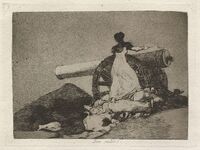 The print Que Valor! is Plate 7 in Goya’s Desastres de la Guerra series. The print centers on a woman manning a large cannon. The woman is the focal point of the piece, wearing a white dress that stands out from most of the rest of the print, being rendered in a clearer white than the rest of the image. From the middle of her back up, the woman is rendered in a darker - gray to black tone. This tonal shift differs from the other figures present in the piece, and in Goya’s larger work. The woman is now made somewhat anonymous, her face obscured by the tone in which she is etched, and that her face is turned away from the audience. Her arm is the other unobscured part of her body, and we can see it light the cannon in preparation for it to fire. The cannon is rendered in darker tones, with the wheels appearing in the darkest. The barrel of the cannon, to the left of the wheels, is a bright white, with the underside in shadow. The bright white of the barrel is comparable to the white of the woman’s dress. While most of Goya’s prints do not focus on any specific event or person, this may be one of the few that does. The woman in question may be Augustina de Aragon, who was a folk heroic figure who defended Spain against Napoleonic forces.
The print Que Valor! is Plate 7 in Goya’s Desastres de la Guerra series. The print centers on a woman manning a large cannon. The woman is the focal point of the piece, wearing a white dress that stands out from most of the rest of the print, being rendered in a clearer white than the rest of the image. From the middle of her back up, the woman is rendered in a darker - gray to black tone. This tonal shift differs from the other figures present in the piece, and in Goya’s larger work. The woman is now made somewhat anonymous, her face obscured by the tone in which she is etched, and that her face is turned away from the audience. Her arm is the other unobscured part of her body, and we can see it light the cannon in preparation for it to fire. The cannon is rendered in darker tones, with the wheels appearing in the darkest. The barrel of the cannon, to the left of the wheels, is a bright white, with the underside in shadow. The bright white of the barrel is comparable to the white of the woman’s dress. While most of Goya’s prints do not focus on any specific event or person, this may be one of the few that does. The woman in question may be Augustina de Aragon, who was a folk heroic figure who defended Spain against Napoleonic forces. -
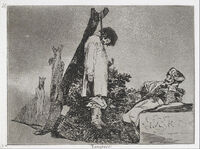 Tampoco is the 36th plate in the Desastres de la Guerra print series. The focal point of this print is a man being hung on a large tree branch. The man is dead, having been hung, as his neck is tilted downward with the heft of the rope that has snapped it. The man wears a white poncho, and is the brightest shade in the composition. In the right of the print, a man in a military officer’s uniform watches the hanged man intently. The military officer’s outfit is reminiscent of a Napoleonic officer’s garb. The officer looks on intently, with his arm resting on his cheek, apparently viewing the hanging as a pleasant scene. The block that the officer is resting his arm on appears to have evidence of writing on it. If there was writing, it is not apparent if it was ever legible. In the background of the print, two other corpses hang from trees, also limp with death. https://www.metmuseum.org/art/collection/search/334470
Tampoco is the 36th plate in the Desastres de la Guerra print series. The focal point of this print is a man being hung on a large tree branch. The man is dead, having been hung, as his neck is tilted downward with the heft of the rope that has snapped it. The man wears a white poncho, and is the brightest shade in the composition. In the right of the print, a man in a military officer’s uniform watches the hanged man intently. The military officer’s outfit is reminiscent of a Napoleonic officer’s garb. The officer looks on intently, with his arm resting on his cheek, apparently viewing the hanging as a pleasant scene. The block that the officer is resting his arm on appears to have evidence of writing on it. If there was writing, it is not apparent if it was ever legible. In the background of the print, two other corpses hang from trees, also limp with death. https://www.metmuseum.org/art/collection/search/334470 -
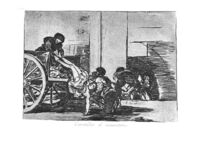 Carretadas al Cementerio is the 64th plate in the Desastres de la Guerra print series. The focal point of this print is a group of people unloading a body from a wooden, wheeled cart. The figure being taken out of the cart appears to have the most romanticized physical form of any of the figures in Desastres de la Guerra. The arm of this corpse is splayed out at their side, exposing the top of their chest, and giving a romanticized look at their physical form. The figures that are lifting the body out of the cart are clothed in heavy, dark clothes, more in line with how Goya usually portrays his figures. In the background, it appears as if another figure is piling bodies into a stone tunnel. This print, specifically the background, is made up of strong, horizontal lines. There are strong shadows that make up much of the composition of the print, and create the sense of depth and sorrow that builds up from the task of carrying the bodies of the dead to the cemetery. https://www.metmuseum.org/art/collection/search/381379
Carretadas al Cementerio is the 64th plate in the Desastres de la Guerra print series. The focal point of this print is a group of people unloading a body from a wooden, wheeled cart. The figure being taken out of the cart appears to have the most romanticized physical form of any of the figures in Desastres de la Guerra. The arm of this corpse is splayed out at their side, exposing the top of their chest, and giving a romanticized look at their physical form. The figures that are lifting the body out of the cart are clothed in heavy, dark clothes, more in line with how Goya usually portrays his figures. In the background, it appears as if another figure is piling bodies into a stone tunnel. This print, specifically the background, is made up of strong, horizontal lines. There are strong shadows that make up much of the composition of the print, and create the sense of depth and sorrow that builds up from the task of carrying the bodies of the dead to the cemetery. https://www.metmuseum.org/art/collection/search/381379 -
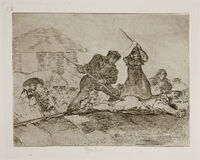 Populacho is the 28th print in the Desastres de la Guerra series. The focal point of the print is a man and a woman positioned over a body laying on the ground. The man, the central figure on the right, is a man wielding a pitchfork, and stabbing the body laying on the ground. The central figure on the left is a woman wielding a thin club, and moving to strike the figure laying on the ground. The figure on the ground does not appear to be dead, and is partially raising their arms about their head as they are hit by the other two central figures. The figure is also fully clothed, but is not wearing any shoes. Behind this grisly scene is a gathered group of figures that appear in less definition than the three central figures. The most prominent of these background observers is a man wearing a large black hat. He stands in contrast to the rest of the crowd, who are instead portrayed in lighter tones. He also appears to be dressed in a military officer’s uniform. The crowd watching this scene of violence appears to be relatively unbothered by the scene unfolding, as no one is moving to stop the violence, or join in themselves.
Populacho is the 28th print in the Desastres de la Guerra series. The focal point of the print is a man and a woman positioned over a body laying on the ground. The man, the central figure on the right, is a man wielding a pitchfork, and stabbing the body laying on the ground. The central figure on the left is a woman wielding a thin club, and moving to strike the figure laying on the ground. The figure on the ground does not appear to be dead, and is partially raising their arms about their head as they are hit by the other two central figures. The figure is also fully clothed, but is not wearing any shoes. Behind this grisly scene is a gathered group of figures that appear in less definition than the three central figures. The most prominent of these background observers is a man wearing a large black hat. He stands in contrast to the rest of the crowd, who are instead portrayed in lighter tones. He also appears to be dressed in a military officer’s uniform. The crowd watching this scene of violence appears to be relatively unbothered by the scene unfolding, as no one is moving to stop the violence, or join in themselves. -
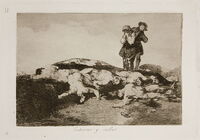 Enterrar y Callar is the 18th print in the Desastres de la Guerra print series. The focal point of the print is the pile of bodies in the foreground and midground of the print. The bodies on the pile are naked, and sprawled out over the hills that make up the mid-ground of the print. There are 9 total corpses in the pile, and all are strewn around the composition, positioned at odd angles, their bodies contorted in unnatural positions. Above the pile, and the hills, are two figures standing together. The figures are a man and a woman, both covering their faces in an expression of grief. The woman is completely covering her face with her hands, and is wearing a hood, and a dress. The woman is covering her face with a rag as well. The man is wearing all black, with a brimmed hat, and is likewise covering his face, holding his nose with his right hand. The sky is created with two tones, with a light, sepia tone creating the top of the sky, and giving the appearance of clouds. Both figures in the composition represent a nascent expression of grief and disgust as they view the gathered corpses.
Enterrar y Callar is the 18th print in the Desastres de la Guerra print series. The focal point of the print is the pile of bodies in the foreground and midground of the print. The bodies on the pile are naked, and sprawled out over the hills that make up the mid-ground of the print. There are 9 total corpses in the pile, and all are strewn around the composition, positioned at odd angles, their bodies contorted in unnatural positions. Above the pile, and the hills, are two figures standing together. The figures are a man and a woman, both covering their faces in an expression of grief. The woman is completely covering her face with her hands, and is wearing a hood, and a dress. The woman is covering her face with a rag as well. The man is wearing all black, with a brimmed hat, and is likewise covering his face, holding his nose with his right hand. The sky is created with two tones, with a light, sepia tone creating the top of the sky, and giving the appearance of clouds. Both figures in the composition represent a nascent expression of grief and disgust as they view the gathered corpses. -
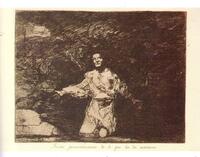 Tristes Presentimientos de lo que ha de Acontecer is the 1st plate in the Desastres de la Guerra print series. The print centers on a man, kneeling down, and spreading his arms out as if welcoming something. The man stands in stark, brilliant contrast to the dark background that surrounds him. He is portrayed in lighter tones, with light, gray lines creating the detailing on his body. The clothes he wears are ragged and tattered, his skirt-like bottom appearing to slough off of his body. His shirt is also torn to tatters, falling off of his body to reveal his chest. His face is crest-fallen, his eyes looking towards the sky, as if expecting a horrifying fate. The background behind him swirls in dark tones. It is possible at first glance to try to see spectral figures lurking in the background, however there is only one definitive creature lurking in the background. The creature is located in the very top of the print, between the center and the right of the print, its beady eyes staring clearly out of the darkness. Upon closer inspection, we can see that the creature has a feline form, exemplified by the apparent curves of the edge of its face. The title of the print, Tristes Pensamientos de lo que ha de Acontecer, translates to “Sad premonitions of what is to come''. The title and the print are a perfect encapsulation, and preview of the series, cuing in audiences to what is to come in the series.
Tristes Presentimientos de lo que ha de Acontecer is the 1st plate in the Desastres de la Guerra print series. The print centers on a man, kneeling down, and spreading his arms out as if welcoming something. The man stands in stark, brilliant contrast to the dark background that surrounds him. He is portrayed in lighter tones, with light, gray lines creating the detailing on his body. The clothes he wears are ragged and tattered, his skirt-like bottom appearing to slough off of his body. His shirt is also torn to tatters, falling off of his body to reveal his chest. His face is crest-fallen, his eyes looking towards the sky, as if expecting a horrifying fate. The background behind him swirls in dark tones. It is possible at first glance to try to see spectral figures lurking in the background, however there is only one definitive creature lurking in the background. The creature is located in the very top of the print, between the center and the right of the print, its beady eyes staring clearly out of the darkness. Upon closer inspection, we can see that the creature has a feline form, exemplified by the apparent curves of the edge of its face. The title of the print, Tristes Pensamientos de lo que ha de Acontecer, translates to “Sad premonitions of what is to come''. The title and the print are a perfect encapsulation, and preview of the series, cuing in audiences to what is to come in the series. -
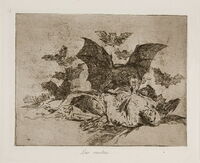 This plate, Las Resultas, is plate 72 from Desastres de la Guerra. The print centers on a figure laying down on the ground. The figure is represented in lighter shades, his clothes covering his body, and his face shown, with a blank expression on it, as he appears to be dead or unconscious. On top of the figure is a large, black bat-like creature. The bat-creature has the body of a bat, but the head is somewhat reminiscent of a bird of prey, although it does not fully look like one. The head of the bat-creature is portrayed in white, while the rest of the creature is made up of black lines. We can clearly see the mandibles of the bat-creature grab the man’s shirt, while its eyes look uncannily forward. In the midground of the print, a group of silhouettes of the bat-creatures approach the body of the central figure. There is little to no detailing on these mid-ground creatures, but we can see that they are approaching the figure, likely to gorge themselves on his remains. The rest of the print is not highly detailed, with the background mainly being taken up by white space. The title, Las Resultas, translates to “The Results”, likely referring to the results of the war, and the loss of life that sprung from it.
This plate, Las Resultas, is plate 72 from Desastres de la Guerra. The print centers on a figure laying down on the ground. The figure is represented in lighter shades, his clothes covering his body, and his face shown, with a blank expression on it, as he appears to be dead or unconscious. On top of the figure is a large, black bat-like creature. The bat-creature has the body of a bat, but the head is somewhat reminiscent of a bird of prey, although it does not fully look like one. The head of the bat-creature is portrayed in white, while the rest of the creature is made up of black lines. We can clearly see the mandibles of the bat-creature grab the man’s shirt, while its eyes look uncannily forward. In the midground of the print, a group of silhouettes of the bat-creatures approach the body of the central figure. There is little to no detailing on these mid-ground creatures, but we can see that they are approaching the figure, likely to gorge themselves on his remains. The rest of the print is not highly detailed, with the background mainly being taken up by white space. The title, Las Resultas, translates to “The Results”, likely referring to the results of the war, and the loss of life that sprung from it. -
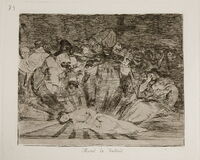 Plate 79 of Desastres de la Guerra is Murio la Verdad. The print centers on a woman laying on the ground, her breasts exposed, and light emanating from her. The light is portrayed with alternating swatches of light and dark. A crowd stands over the woman, looking down at her body. The central figure standing over her is dressed as a pontiff, wearing the large hat, as well as the robes of the holy office. His face is darkened by shadow, and his hands are raised over the woman. Surrounding him is an interesting gaggle of figures. The figures on the left of the pontiff are wearing hoods, and one wields a shovel, positioned in a motion that looks like he is burying the woman. On the right, a woman, who is sitting down, covers her eyes with her arm. This woman appears to be blinded by the radiance of the central woman, or is covering her eyes from the horrors that are befalling her. Behind the pontiff, a group of people is seen. The group has a variety of expressions, but most of the faces are not detailed enough to make out. The crowd is both viewing the body of the central woman, and going about it’s day. There is not an enraptured audience as we see in Si Resucitara?. This piece creates an interesting companion piece to Si Resucitara?. The prints share similar thematic qualities, specifically a central female figure laying on the ground as a gathered crowd surrounds her. The title, Murio la Verdad translates to “Truth has died”, likely meaning that the central woman is Truth. Given this, we can reasonably extrapolate that the central woman in Si Resucitara? is also Truth.
Plate 79 of Desastres de la Guerra is Murio la Verdad. The print centers on a woman laying on the ground, her breasts exposed, and light emanating from her. The light is portrayed with alternating swatches of light and dark. A crowd stands over the woman, looking down at her body. The central figure standing over her is dressed as a pontiff, wearing the large hat, as well as the robes of the holy office. His face is darkened by shadow, and his hands are raised over the woman. Surrounding him is an interesting gaggle of figures. The figures on the left of the pontiff are wearing hoods, and one wields a shovel, positioned in a motion that looks like he is burying the woman. On the right, a woman, who is sitting down, covers her eyes with her arm. This woman appears to be blinded by the radiance of the central woman, or is covering her eyes from the horrors that are befalling her. Behind the pontiff, a group of people is seen. The group has a variety of expressions, but most of the faces are not detailed enough to make out. The crowd is both viewing the body of the central woman, and going about it’s day. There is not an enraptured audience as we see in Si Resucitara?. This piece creates an interesting companion piece to Si Resucitara?. The prints share similar thematic qualities, specifically a central female figure laying on the ground as a gathered crowd surrounds her. The title, Murio la Verdad translates to “Truth has died”, likely meaning that the central woman is Truth. Given this, we can reasonably extrapolate that the central woman in Si Resucitara? is also Truth. -
 The print Fiero Monstruo! is Plate 81 in Goya's Desastres de la Guerra series. Although the series originally contained only 80 plates, plates 81-82 were found later, and added to later editions. The print centers on a large creature, with what appears to be the head of an aardvark, and the body of a dog or a hare. The creature is laying on its side, with all four of its feet clearly shown. The feet resemble that of a hare or a dog. The creature’s body is covered in lines as indicative of fur, with the front legs of the creature being the lightest part of it by far. The creature’s mouth is elongated, part mouth, and part beak. The creature has gorged itself on human bodies, and is in the process of throwing them up. The bodies spill from the creature’s mouth, and onto the ground, in a nondescript pile. The bodies have enough detailing to tell each body and part apart, but are not highly detailed, like in some other of Goya’s etchings.
The print Fiero Monstruo! is Plate 81 in Goya's Desastres de la Guerra series. Although the series originally contained only 80 plates, plates 81-82 were found later, and added to later editions. The print centers on a large creature, with what appears to be the head of an aardvark, and the body of a dog or a hare. The creature is laying on its side, with all four of its feet clearly shown. The feet resemble that of a hare or a dog. The creature’s body is covered in lines as indicative of fur, with the front legs of the creature being the lightest part of it by far. The creature’s mouth is elongated, part mouth, and part beak. The creature has gorged itself on human bodies, and is in the process of throwing them up. The bodies spill from the creature’s mouth, and onto the ground, in a nondescript pile. The bodies have enough detailing to tell each body and part apart, but are not highly detailed, like in some other of Goya’s etchings. -
 The print Si Rescuitara? is plate 80 in Goya 's Los Desastres de la Guerra print series. Si Rescuitara? shows a dark scene both in terms of tone and theme. The central figure of this print is a woman in a white dress laying on the ground. The woman is wreathed in a strong, bright light. That light radiates barely onto a crowd gathered around the woman. The woman has a calm, serene look on her face. Directly to the right of her, a sinister group of figures is gathered. To the far right, a man in a white robe, brandishing a club. To his left, a man in a dark robe brandishes a gun at the woman. To his immediate left, a strange figure wields a book above his head. This man appears to have the head of a dog or a walrus. His figure follows a strong tradition of strange creatures by Goya. Many of Goya’s prints show a variety of strange, horrifying, and fantastical creatures. In addition to this figure, a group of strange creatures hover in the far right background. These figures are mostly obscured by the dark lines of the print. This print does not employ the technique of aquatint to create the tones of the print. To the left of the walrus-headed figures, a second crowd of figures is gathered. The crowd of figures is standing in a position indicating mourning. They have their heads turned down, and their mouths look to be gagged. This group of people are standing as a solemn crowd, not intervening or acting on anything they are seeing. In addition, the name “Goya” is signed in intaglio, while being upside down and reversed. In this edition, the mark is barely visible, and close inspection is needed to see it. The plate belongs to the “caprichos” section of Desastres. This includes allegorical plates, which Si Resucitara? definitely belongs to. The plate could take on any amount of meanings, but a possible interpretation could be one of freedom. The woman could represent freedom, being stifled by any number of groups, including the Church, or the military, either French or Spanish. This print shows a reality of grappling with Goya’s works. Many of Goya’s works, whether they be prints or paintings, can take on multiple meanings and interpretations. Goya was not one to give detailed reasoning or artists statements for his prints, so many of them remain somewhat of a transfixing mystery.
The print Si Rescuitara? is plate 80 in Goya 's Los Desastres de la Guerra print series. Si Rescuitara? shows a dark scene both in terms of tone and theme. The central figure of this print is a woman in a white dress laying on the ground. The woman is wreathed in a strong, bright light. That light radiates barely onto a crowd gathered around the woman. The woman has a calm, serene look on her face. Directly to the right of her, a sinister group of figures is gathered. To the far right, a man in a white robe, brandishing a club. To his left, a man in a dark robe brandishes a gun at the woman. To his immediate left, a strange figure wields a book above his head. This man appears to have the head of a dog or a walrus. His figure follows a strong tradition of strange creatures by Goya. Many of Goya’s prints show a variety of strange, horrifying, and fantastical creatures. In addition to this figure, a group of strange creatures hover in the far right background. These figures are mostly obscured by the dark lines of the print. This print does not employ the technique of aquatint to create the tones of the print. To the left of the walrus-headed figures, a second crowd of figures is gathered. The crowd of figures is standing in a position indicating mourning. They have their heads turned down, and their mouths look to be gagged. This group of people are standing as a solemn crowd, not intervening or acting on anything they are seeing. In addition, the name “Goya” is signed in intaglio, while being upside down and reversed. In this edition, the mark is barely visible, and close inspection is needed to see it. The plate belongs to the “caprichos” section of Desastres. This includes allegorical plates, which Si Resucitara? definitely belongs to. The plate could take on any amount of meanings, but a possible interpretation could be one of freedom. The woman could represent freedom, being stifled by any number of groups, including the Church, or the military, either French or Spanish. This print shows a reality of grappling with Goya’s works. Many of Goya’s works, whether they be prints or paintings, can take on multiple meanings and interpretations. Goya was not one to give detailed reasoning or artists statements for his prints, so many of them remain somewhat of a transfixing mystery. -
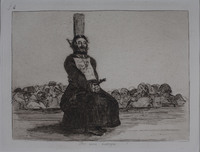 Por una Navaja (On the account of a knife) is the 34th plate in the Desastres series of prints. The print centers on a man tied to a stake. The man is the central figure of the print, and appears to be on a large stage, devoid of people. The central figure appears to be a priest, wearing a black robe, and is holding a small cross in his hands. The man’s eyes are closed and his face appears “at peace”. The man appears to be middle-aged, or older, with a wizened face, and a beard, and gangly hair. Around his neck, is a small string, with a piece of rolled up paper tied to it. Also, posted on his chest is a larger piece of paper that reads “Por ….”, with the rest of the text being unreadable. There is also what appears to be a stake sticking out of the back of what appears to be the priest. In the background, and just above the ground plane, a gaggle of figures watches this macabre scene. The figures mostly look away from the scene, with their heads covered, and eyes averted. The priest is most likely dead, and this appears to be his punishment for a crime he committed. The title “on the account of a knife”, could tell us what his sentence is. The priest could have been convicted of stealing a knife, or possessing one. This print could show what Goya believed to be ridiculous punishments. Goya’s other series often involve a sense of social satire or irony, criticizing systems that exist in the world.
Por una Navaja (On the account of a knife) is the 34th plate in the Desastres series of prints. The print centers on a man tied to a stake. The man is the central figure of the print, and appears to be on a large stage, devoid of people. The central figure appears to be a priest, wearing a black robe, and is holding a small cross in his hands. The man’s eyes are closed and his face appears “at peace”. The man appears to be middle-aged, or older, with a wizened face, and a beard, and gangly hair. Around his neck, is a small string, with a piece of rolled up paper tied to it. Also, posted on his chest is a larger piece of paper that reads “Por ….”, with the rest of the text being unreadable. There is also what appears to be a stake sticking out of the back of what appears to be the priest. In the background, and just above the ground plane, a gaggle of figures watches this macabre scene. The figures mostly look away from the scene, with their heads covered, and eyes averted. The priest is most likely dead, and this appears to be his punishment for a crime he committed. The title “on the account of a knife”, could tell us what his sentence is. The priest could have been convicted of stealing a knife, or possessing one. This print could show what Goya believed to be ridiculous punishments. Goya’s other series often involve a sense of social satire or irony, criticizing systems that exist in the world. -
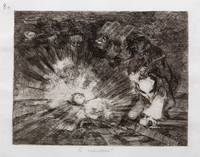 The print Si Rescuitara? is plate 80 in Goya 's Los Desastres de la Guerra print series. Si Rescuitara? shows a dark scene both in terms of tone and theme. The central figure of this print is a woman in a white dress laying on the ground. The woman is wreathed in a strong, bright light. That light radiates barely onto a crowd gathered around the woman. The woman has a calm, serene look on her face. Directly to the right of her, a sinister group of figures is gathered. To the far right, a man in a white robe, brandishing a club. To his left, a man in a dark robe brandishes a gun at the woman. To his immediate left, a strange figure wields a book above his head. This man appears to have the head of a dog or a walrus. His figure follows a strong tradition of strange creatures by Goya. Many of Goya’s prints show a variety of strange, horrifying, and fantastical creatures. In addition to this figure, a group of strange creatures hover in the far right background. These figures are mostly obscured by the dark lines of the print. This print does not employ the technique of aquatint to create the tones of the print. To the left of the walrus-headed figures, a second crowd of figures is gathered. The crowd of figures is standing in a position indicating mourning. They have their heads turned down, and their mouths look to be gagged. This group of people are standing as a solemn crowd, not intervening or acting on anything they are seeing. The plate belongs to the “caprichos” section of Desastres. This includes allegorical plates, which Si Resucitara? definitely belongs to. The plate could take on any amount of meanings, but a possible interpretation could be one of freedom. The woman could represent freedom, being stifled by any number of groups, including the Church, or the military, either French or Spanish. This print shows a reality of grappling with Goya’s works. Many of Goya’s works, whether they be prints or paintings, can take on multiple meanings and interpretations. Goya was not one to give detailed reasoning or artists statements for his prints, so many of them remain somewhat of a transfixing mystery.
The print Si Rescuitara? is plate 80 in Goya 's Los Desastres de la Guerra print series. Si Rescuitara? shows a dark scene both in terms of tone and theme. The central figure of this print is a woman in a white dress laying on the ground. The woman is wreathed in a strong, bright light. That light radiates barely onto a crowd gathered around the woman. The woman has a calm, serene look on her face. Directly to the right of her, a sinister group of figures is gathered. To the far right, a man in a white robe, brandishing a club. To his left, a man in a dark robe brandishes a gun at the woman. To his immediate left, a strange figure wields a book above his head. This man appears to have the head of a dog or a walrus. His figure follows a strong tradition of strange creatures by Goya. Many of Goya’s prints show a variety of strange, horrifying, and fantastical creatures. In addition to this figure, a group of strange creatures hover in the far right background. These figures are mostly obscured by the dark lines of the print. This print does not employ the technique of aquatint to create the tones of the print. To the left of the walrus-headed figures, a second crowd of figures is gathered. The crowd of figures is standing in a position indicating mourning. They have their heads turned down, and their mouths look to be gagged. This group of people are standing as a solemn crowd, not intervening or acting on anything they are seeing. The plate belongs to the “caprichos” section of Desastres. This includes allegorical plates, which Si Resucitara? definitely belongs to. The plate could take on any amount of meanings, but a possible interpretation could be one of freedom. The woman could represent freedom, being stifled by any number of groups, including the Church, or the military, either French or Spanish. This print shows a reality of grappling with Goya’s works. Many of Goya’s works, whether they be prints or paintings, can take on multiple meanings and interpretations. Goya was not one to give detailed reasoning or artists statements for his prints, so many of them remain somewhat of a transfixing mystery.